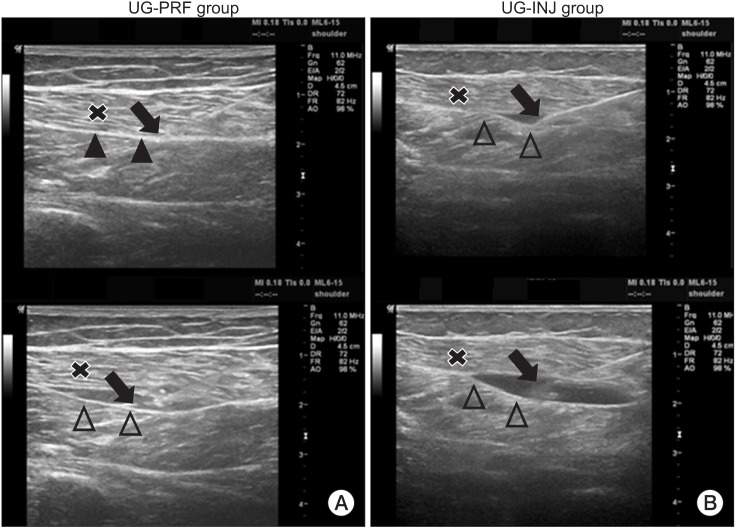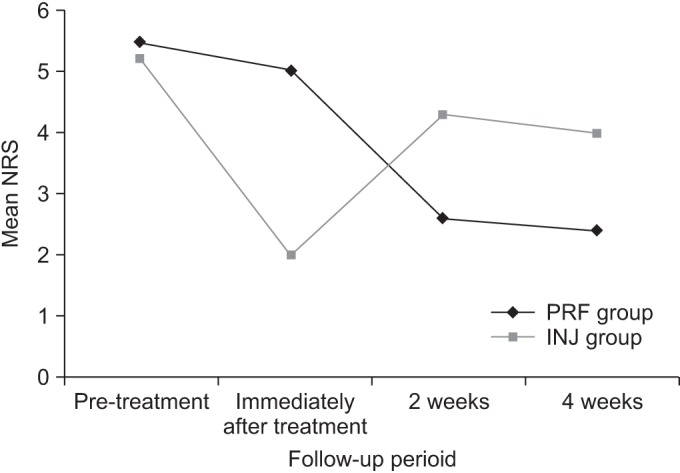Ann Rehabil Med.
2016 Oct;40(5):885-892. 10.5535/arm.2016.40.5.885.
Comparison of the Effects of Ultrasound-Guided Interfascial Pulsed Radiofrequency and Ultrasound-Guided Interfascial Injection on Myofascial Pain Syndrome of the Gastrocnemius
- Affiliations
-
- 1Department of Physical Medicine and Rehabilitation, Yeungnam University College of Medicine, Daegu, Korea. yup331@hanmail.net
- 2Department of Rehabilitation Medicine & Spine Center, Yeungnam University Medical Center, Daegu, Korea.
- 3Medical Devices Clinical Trial Center, Yeungnam University, Daegu, Korea.
- 4Department of Physical Medicine and Rehabilitation, Keimyung University School of Medicine, Daegu, Korea.
- 5Department of Physical Medicine and Rehabilitation, Catholic University of Daegu School of Medicine, Daegu, Korea.
- KMID: 2382921
- DOI: http://doi.org/10.5535/arm.2016.40.5.885
Abstract
OBJECTIVE
To investigate the comparative treatment effects of ultrasound-guided pulsed radiofrequency treatment (UG-PRF) in the gastrocnemius interfascial space and ultrasound-guided interfascial injection (UG-INJ) on myofascial pain syndrome.
METHODS
Forty consecutive patients with myofascial pain syndrome of the gastrocnemius were enrolled and were allocated to one of the two groups. Twenty patients were treated by UG-PRF delivered to the gastrocnemius interfascial space (UG-PRF group) and the other 20 patients were treated by interfascial injection (UG-INJ group). The primary outcome measure was the numeric rating score (NRS) for pain on pressing the tender point in the gastrocnemius, and the secondary outcome measure was health-related quality of life as determined by the Short Form-36 questionnaire (SF-36). NRSs were obtained at the first visit, immediately after treatment, and at 2 and 4 weeks post-treatment, and physical component summary scores (PCS) and mental component summary scores (MCS) of the SF-36 questionnaire were measured at the first visit and at 4 weeks post-treatment.
RESULTS
Immediately after treatments, mean NRS in the UG-PRF group was significantly higher than that in the UG-INJ group (p<0.0001). However, at 2 and 4 weeks post-treatment, the mean NRS was significantly lower in the UG-PRF group (both p<0.0001). Similarly, at 4 weeks post-treatment, mean PCS and MCS were significantly higher in the UG-PRF group (p<0.0001 and p=0.002, respectively).
CONCLUSION
Based on these results, the authors conclude that ultrasound-guided gastrocnemius interfascial PRF provides an attractive treatment for myofascial pain syndrome of the gastrocnemius.
Keyword
MeSH Terms
Figure
Reference
-
1. Skootsky SA, Jaeger B, Oye RK. Prevalence of myofascial pain in general internal medicine practice. West J Med. 1989; 151:157–160. PMID: 2788962.2. Simons DG, Mense S. Understanding and measurement of muscle tone as related to clinical muscle pain. Pain. 1998; 75:1–17. PMID: 9539669.
Article3. Benjamin M. The fascia of the limbs and back: a review. J Anat. 2009; 214:1–18. PMID: 19166469.4. Stecco A, Macchi V, Masiero S, Porzionato A, Tiengo C, Stecco C, et al. Pectoral and femoral fasciae: common aspects and regional specializations. Surg Radiol Anat. 2009; 31:35–42. PMID: 18663404.
Article5. Domingo T, Blasi J, Casals M, Mayoral V, Ortiz-Sagrista JC, Miguel-Perez M. Is interfascial block with ultrasound-guided puncture useful in treatment of myofascial pain of the trapezius muscle? Clin J Pain. 2011; 27:297–303. PMID: 21317780.
Article6. Hong CZ. Lidocaine injection versus dry needling to myofascial trigger point: the importance of the local twitch response. Am J Phys Med Rehabil. 1994; 73:256–263. PMID: 8043247.7. Chu J, Yuen KF, Wang BH, Chan RC, Schwartz I, Neuhauser D. Electrical twitch-obtaining intramuscular stimulation in lower back pain: a pilot study. Am J Phys Med Rehabil. 2004; 83:104–111. PMID: 14758296.8. McDonnell JG, O'Donnell B, Curley G, Heffernan A, Power C, Laffey JG. The analgesic efficacy of transversus abdominis plane block after abdominal surgery: a prospective randomized controlled trial. Anesth Analg. 2007; 104:193–197. PMID: 17179269.
Article9. Hebbard P. Subcostal transversus abdominis plane block under ultrasound guidance. Anesth Analg. 2008; 106:674–675. PMID: 18227342.
Article10. Van Zundert J, de Louw AJ, Joosten EA, Kessels AG, Honig W, Dederen PJ, et al. Pulsed and continuous radiofrequency current adjacent to the cervical dorsal root ganglion of the rat induces late cellular activity in the dorsal horn. Anesthesiology. 2005; 102:125–131. PMID: 15618796.11. Abejon D, Reig E. Is pulsed radiofrequency a neuromodulation technique? Neuromodulation. 2003; 6:1–3. PMID: 22150906.12. Bevacqua B, Fattouh M. Pulsed radiofrequency for treatment of painful trigger points. Pain Pract. 2008; 8:149–150. PMID: 18366471.
Article13. Tamimi MA, McCeney MH, Krutsch J. A case series of pulsed radiofrequency treatment of myofascial trigger points and scar neuromas. Pain Med. 2009; 10:1140–1143. PMID: 19594852.14. Ye L, Mei Q, Li M, Gu M, Ai Z, Tang K, et al. A comparative efficacy evaluation of ultrasound-guided pulsed radiofrequency treatment in the gastrocnemius in managing plantar heel pain: a randomized and controlled trial. Pain Med. 2015; 16:782–790. PMID: 25715902.
Article15. Simons DG. New views of myofascial trigger points: etiology and diagnosis. Arch Phys Med Rehabil. 2008; 89:157–159. PMID: 18164347.
Article16. Simons DG, Travell JG, Simons LS. Travell & Simons' myofascial pain and dysfunction: the trigger point manual. 2nd ed. Baltimore: Williams & Wilkins;1999.17. Jaeger B. Myofascial trigger point pain. Alpha Omegan. 2013; 106:14–22. PMID: 24864393.18. Shankar H, Reddy S. Two- and three-dimensional ultrasound imaging to facilitate detection and targeting of taut bands in myofascial pain syndrome. Pain Med. 2012; 13:971–975. PMID: 22681185.
Article19. Farrar JT, Young JP Jr, LaMoreaux L, Werth JL, Poole RM. Clinical importance of changes in chronic pain intensity measured on an 11-point numerical pain rating scale. Pain. 2001; 94:149–158. PMID: 11690728.
Article20. Ware JE Jr. SF-36 health survey update. Spine (Phila Pa 1976). 2000; 25:3130–3139. PMID: 11124729.
Article21. French JL, McCullough J, Bachra P, Bedforth NM. Transversus abdominis plane block for analgesia after caesarean section in a patient with an intracranial lesion. Int J Obstet Anesth. 2009; 18:52–54. PMID: 18996002.
Article22. Tran TM, Ivanusic JJ, Hebbard P, Barrington MJ. Determination of spread of injectate after ultrasound-guided transversus abdominis plane block: a cadaveric study. Br J Anaesth. 2009; 102:123–127. PMID: 19059922.
Article23. Snidvongs S, Mehta V. Pulsed radio frequency: a non-neurodestructive therapy in pain management. Curr Opin Support Palliat Care. 2010; 4:107–110. PMID: 20440207.
Article24. Erdine S, Bilir A, Cosman ER, Cosman ER. Ultrastructural changes in axons following exposure to pulsed radiofrequency fields. Pain Pract. 2009; 9:407–417. PMID: 19761513.
Article25. Moffett J, Fray LM, Kubat NJ. Activation of endogenous opioid gene expression in human keratinocytes and fibroblasts by pulsed radiofrequency energy fields. J Pain Res. 2012; 5:347–357. PMID: 23055776.
Article26. Vallejo R, Tilley DM, Williams J, Labak S, Aliaga L, Benyamin RM. Pulsed radiofrequency modulates pain regulatory gene expression along the nociceptive pathway. Pain Physician. 2013; 16:E601–E613. PMID: 24077210.
- Full Text Links
- Actions
-
Cited
- CITED
-
- Close
- Share
- Similar articles
-
- Treatment Experience of Pulsed Radiofrequency Under Ultrasound Guided to the Trapezius Muscle at Myofascial Pain Syndrome: A Case Report
- Ultrasound imaging and guidance in the management of myofascial pain syndrome: a narrative review
- Ultrasound-guided pulsed radiofrequency treatment for postherpetic neuralgia of supraorbital nerve: A case report
- Ultrasound-guided Pulsed Radiofrequency of the Third Occipital Nerve
- Usefulness of Ultrasound for Carpal Tunnel Syndrome Proven in Meta-Analysis Studies



